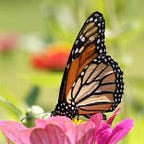FWS Scholar: David Sherer
David Sherer grew up in a semi-rural community in northeast Florida, with a 5-minute walk to the beach, so as a kid he spent much of his time outdoors. This exposed David to wildlife almost daily and he became interested in learning about the natural world. As a young boy, he had the opportunity to band a Carolina Wren at Cade’s Cove in the Smokies which sparked a life-long love affair with birds. His grandparents were science educators who shared their love of biology with David, so this became his occupational focus.
David earned a Bachelor of Science in Wildlife and Fisheries Science, Conservation Biology from Tennessee Tech University. He learned about the U.S. Fish and Wildlife Service while he was in college and decided the Service was where he wanted to work. He tailored his coursework and professional experiences toward acquiring the skills he saw listed on job announcements, but quickly determined an advanced degree would give him a competitive edge.
“Our agency is the premier federal conservation organization, and my own interests in conserving and perpetuating the same biodiversity I grew up with are strongly aligned with the Service’s mission,” David explains.
David bridged a 3-year gap between undergraduate and graduate studies with research internships at Point Blue Conservation Science and Archbold Biological Station. During the last year of his master’s degree program, David completed a Directorate Resource Assistants Fellowship (DFP) with the Service at the Attwater Prairie Chicken National Wildlife Refuge in Eagle Lake, Texas. It was, in a sense, an extended interview and he completed critical work during an 11-week project while also learning about the Service in the best way he knew how: hands-on. And he liked what he saw!
David earned a Master of Science in Biology from the University of Central Florida. While there, he investigated how a Florida Scrub Jay’s (Aphelocoma coerulescens) personality (bold or shy), and habitat influence where young jays would choose to explore before eventually establishing their own breeding territory. He spent 9 months over 3 years in the field collecting data, and even more time in front of a computer framing his hypotheses and asking what it all means. But the time paid off: David was able to determine that Florida Scrub Jays, which depend on prescribed fire to maintain their habitat in a livable condition, have very different preferences from one individual to another when exploring.
Habitat is limited for this federally threatened species. Young jays will stay with their parents for one or more years until they find an opportunity to disperse. During this time, they foray (temporarily explore) the landscape away from their home territory. David hypothesized that, because Florida scrub habitat is rare and there isn’t enough space for all birds to disperse, and because habitat burned within the last 2 to 10 years (even rarer) is ideal, individual jays might avoid competing for limited space by preferring to explore different habitats.
Through his research, David found that Florida Scrub Jays “stick to what they know” and prefer to explore habitat in a similar time-since-fire interval (history of fire) as their home territory. Since fires are patchy, this interval is highly variable across the landscape, and that variation results in the correspondingly wide range of habitat preference young jays demonstrate during their forays. An individual jay’s personality type also predicted how much recently burned habitat a jay explored.
Following these experiences, David joined the Ventura Fish and Wildlife Office in California as a Fish and Wildlife Biologist. He spends half of his time in the South Coast Division, where he consults with other federal agencies to facilitate their responsibilities under the Endangered Species Act by reviewing projects that may impact listed species. Any time a federal agency authorizes, funds, or carries out such a project in the area it comes through his office for review.
The remaining portion of his time is spent in data science and geographic information systems (GIS) analysis and development, and managing the Coastal Ocean Mammal and Bird Education and Research Surveys project — a citizen science initiative better known as BeachCOMBERS — in partnership with the Moss Landing Marine Lab and the California Department of Fish and Wildlife. David works with BeachCOMBERS staff, volunteers, and partners to develop practical solutions to collect, manage, analyze, interpret and disseminate survey data. The Service is entrusted with conservation on behalf of the public, so working with citizen scientist volunteers is a very special partnership.
To learn more about David’s research on the Florida Scrub Jay check out his research published in the PeerJ Journal, “Life history stage explains behavior in a social network before and during the early breeding season in a cooperatively breeding bird.” For more information on the Florida Scrub Jay visit the link. Brought to you by the USFWS Conservation Library, #FWSScholar.
